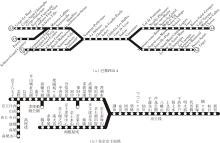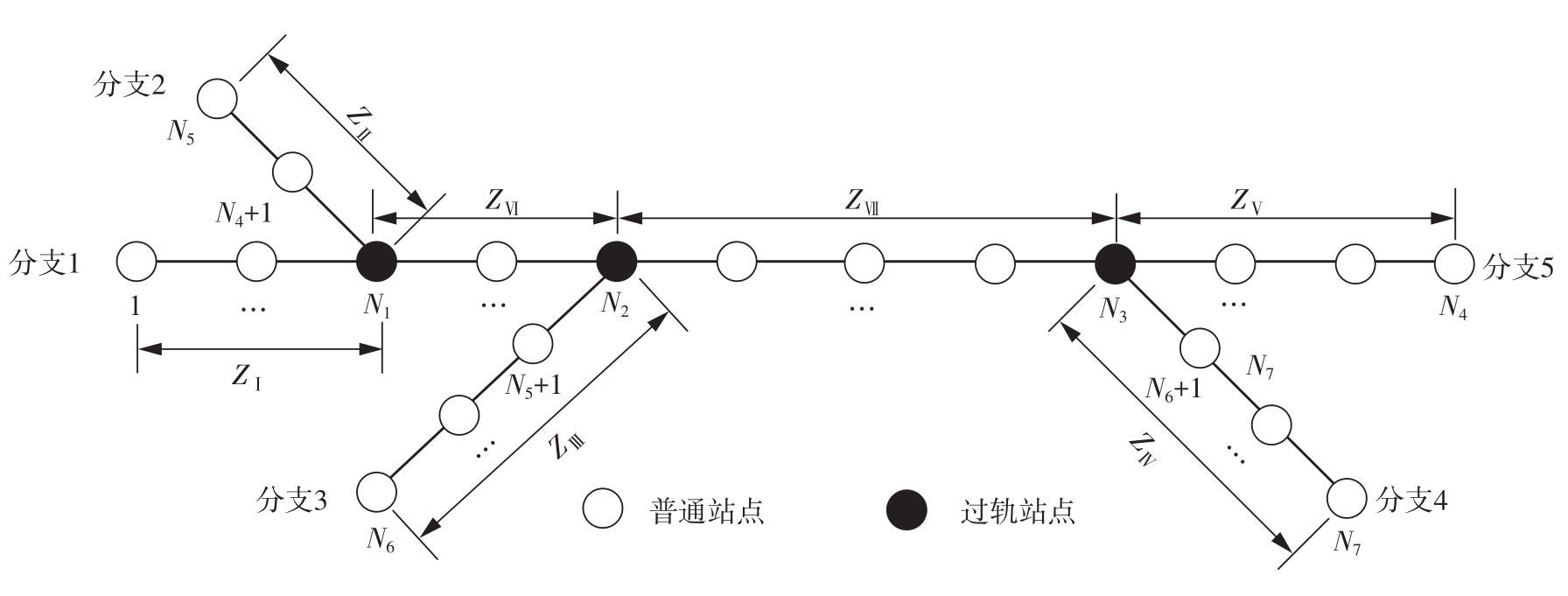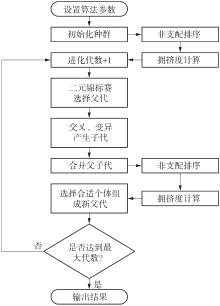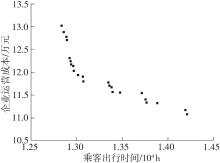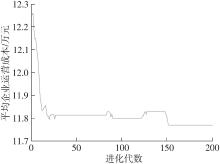Journal of South China University of Technology(Natural Science Edition) ›› 2022, Vol. 50 ›› Issue (11): 44-51.doi: 10.12141/j.issn.1000-565X.220140
Special Issue: 2022年交通运输工程
• Traffic & Transportation Engineering • Previous Articles Next Articles
Optimization of Train Planning for General Tree-Type Line
WEI Runbin1 JIA Shunping1,2 TONG Ruiyong1 ZHANG Shujing1
- 1.School of Traffic and Transportation,Beijing Jiaotong University,Beijing 100044,China
2.Key Laboratory of Transport Industry of Big Data Application Technologies for Comprehensive Transport,Beijing Jiaotong University,Beijing 100044,China
-
Received:2022-03-17Online:2022-11-25Published:2022-07-21 -
Contact:贾顺平(1963-),男,博士,教授,主要从事综合交通运输规划与交通经济分析研究。 E-mail:shpjia@bjtu.edu.cn -
About author:魏润斌(1995-),男,博士生,主要从事城市轨道交通规划与管理研究.E-mail:19114056@bjtu.edu.cn. -
Supported by:the National Natural Science Foundation of China(71971021)
CLC Number:
Cite this article
WEI Runbin, JIA Shunping, TONG Ruiyong, et al. Optimization of Train Planning for General Tree-Type Line[J]. Journal of South China University of Technology(Natural Science Edition), 2022, 50(11): 44-51.
share this article
Table 1
Researches on train planning for Y-type rail transit by Chinese scholars in recent years"
| 作者 | 年份 | 目标函数 | 决策变量 | 停站方案 | 编组方案 |
|---|---|---|---|---|---|
| 江志彬等[ | 2014 | 上线车底数最小;折返时间最小 | 交路开行 列车比例 | 站站停 | 固定编组 |
| Zhao等[ | 2016 | 乘客出行时间最小;列车走行公里最小 | 交路方案 发车频率 | 站站停 | 固定编组 |
| 郭建民等[ | 2017 | 乘客候车时间最小;列车走行公里最小;上线车底数最小 | 交路方案 发车频率 | 站站停 | 固定编组 |
| 李得伟等[ | 2018 | 乘客出行时间最小;列车走行公里最小;上线车底数最小 | 交路方案 发车频率 | 站站停 | 固定编组 |
| 谭丽等[ | 2019 | 乘客出行时间最小;列车走行公里最小;上线车底数最小 | 交路方案 发车频率 | 站站停 | 固定编组 |
| Liu等[ | 2020 | 列车购置成本最小;列车走行公里最小;乘客出行成本最小 | 交路方案 发车频率 | 站站停 | 固定编组 |
| Yang等[ | 2020 | 节省乘客出行时间最大;节省企业运营成本最大 | 交路方案 发车频率 | 快慢车 | 固定编组 |
Table 2
Parameters and variables"
| 参数或变量 | 含义 |
|---|---|
| 分别代表树型线两端的分支 | |
| 车站,车站 | |
| 按线路拓扑结构划分的区段 | |
| 区段 | |
| 分别代表 | |
| 分别代表 | |
| 车站 | |
| 交路 | |
| OD矩阵 | |
| 从 | |
| 交路 | |
| 一次折返时间 | |
| 一次换乘时间 | |
| 分支 | |
| 最小发车频率 | |
| 最大发车频率 | |
| 列车定员,人 | |
| 分别代表上/下行的区间 | |
| 分别代表上/下行的区间 | |
| 最大满载率 | |
| 乘客总出行时间 | |
| 区段 | |
| 区段 | |
| 企业运营成本 | |
| 车辆运营成本 | |
| 车辆使用成本 | |
| 每列列车每公里运营费用 | |
| 每列列车单位时间的折旧费 |
Table 3
Optimization schemes"
| 类别 | 乘客出行时间/h | 企业运营成本/元 | ||||||
|---|---|---|---|---|---|---|---|---|
| 优化方案1 | 8 | 4 | 6 | 0 | 0 | 12 | 12 834.62 | 130 158.00 |
| 优化方案2 | 8 | 4 | 2 | 5 | 4 | 7 | 12 885.40 | 127 783.20 |
| 优化方案3 | 6 | 6 | 3 | 4 | 5 | 6 | 12 894.98 | 127 094.40 |
| 优化方案4 | 2 | 9 | 2 | 4 | 10 | 3 | 12 962.15 | 121 336.80 |
| 优化方案5 | 0 | 10 | 3 | 4 | 11 | 2 | 13 016.11 | 119 383.20 |
| 优化方案6 | 0 | 10 | 2 | 4 | 12 | 2 | 13 076.20 | 118 026.00 |
| 优化方案7 | 0 | 10 | 2 | 4 | 10 | 2 | 13 768.52 | 113 402.40 |
| 优化方案8 | 0 | 10 | 0 | 6 | 11 | 1 | 13 888.28 | 113 197.80 |
| 优化方案9 | 0 | 10 | 2 | 4 | 9 | 2 | 14 210.24 | 110 802.60 |
Table 4
Comparison of split-line scheme and optimization schemes"
| 类别 | 乘客候车时间/h | 乘客换乘时间/h | 列车总走行里程/km | 上线车底数 |
|---|---|---|---|---|
| 分线方案 | 11 892.28 | 3 808.67 | 3 930.60 | 83 |
| 优化方案1 | 10 358.11 | 2 476.51 | 3 628.20 | 74 |
| 优化方案3 | 10 388.50 | 2 506.48 | 3 526.08 | 74 |
| 优化方案4 | 10 440.42 | 2 521.73 | 3 362.96 | 71 |
| 优化方案6 | 10 547.67 | 2 528.53 | 3 281.40 | 68 |
| 优化方案7 | 11 240.41 | 2 528.10 | 3 146.48 | 66 |
| 优化方案9 | 11 682.41 | 2 527.83 | 3 079.02 | 64 |
| 1 | 姚恩建,张金萌,郇宁 .效率与公平导向下城轨大小交路开行方案优化[J].华南理工大学学报(自然科学版),2020,48(5):41-48,57. |
| YAO Enjian, ZHANG Jinmeng, HUAN Ning .Equality-efficiency balance-oriented optimization of long-short route strategy in urban rail transit[J].Journal of South China University of Technology (Natural Science Edition),2020,48(5):41-48,57. | |
| 2 | 谭丽,韦子文 .基于CCLPSO算法的Y型交路列车开行方案优化研究[J].铁道科学与工程学报,2019,16(8):2122-2129. |
| TAN Li, WEI Ziwen .Optimization research of train schedule of Y-type train routing mode based on CCLPSO algorithm[J].Journal of Railway Science and Engineering,2019,16(8):2122-2129. | |
| 3 | 梁青槐,柴树山,邓京维 .区域轨道交通跨线运行行车密度优化模型[J].北京交通大学学报,2020,44(1):20-26. |
| LIANG Qinghuai, CHAI Shushan, DENG Jingwei .Optimization model of train operation density for cross-line in regional rail transit[J].Journal of Beijing Jiaotong University,2020,44(1):20-26. | |
| 4 | ZHAO X, SUN Q, ZHU Y,et al .Multi-routing planning design of Y-type urban rail transit[J].Advances in Mechanical Engineering,2016,8(8):1687814016667385. |
| 5 | RIEJOS F A O, BARRENA E, ORTIZ J D C,et al .Analyzing the theoretical capacity of railway networks with a radial-backbone topology[J].Transportation Research Part A:Policy and Practice,2016,84:83-92. |
| 6 | FIOOLE P J, KROON L, MARÓTI G,et al .A rolling stock circulation model for combining and splitting of passenger trains[J].European Journal of Operational Research,2006,174(2):1281-1297. |
| 7 | 江志彬,徐瑞华,吴强,等 .多交路共线运行的城市轨道交通车辆运用优化[J].同济大学学报(自然科学版),2014,42(9):1333-1339,1431. |
| JIANG Zhibin, XU Ruihua, WU Qiang,et al .Optimal model for using of transit unit based on shared-path rail transit route[J].Journal of Tongji University (Natural Science),2014,42(9):1333-1339,1431. | |
| 8 | 郭建民,韩林飞,周建国,等 .Y形共线模式下轨道交通列车开行方案研究[J].铁道工程学报,2017,34(2):87-92. |
| GUO Jianmin, HAN Linfei, ZHOU Jianguo,et al .Research on the operation scheme for rail transit with the Y-shaped collinear mode[J].Journal of Railway Engineering Society,2017,34(2):87-92. | |
| 9 | 李得伟,刘宗杰,王晓全,等 .考虑乘客选择行为的城轨Y型线交路计划编制[J].中国铁道科学,2018,39(4):114-122. |
| LI Dewei, LIU Zongjie, WANG Xiaoquan,et al .Routing plan for Y-type line of urban rail transit considering passenger choice behavior[J].China Railway Science,2018,39(4):114-122. | |
| 10 | LIU Y, HAN B .Study on train routing plan of Y-line of urban rail transit considering passenger travel purpose[C]∥ Proceedings of the 2019 International Conference on Intelligent Transportation and Vehicle Engineering.Harbin:IOP Publishing,2020:1-11. |
| 11 | YANG A, WANG B, HUANG J,et al .Service replanning in urban rail transit networks:cross-line express trains for reducing the number of passenger transfers and travel time[J].Transportation Research Part C:Emerging Technologies,2020,115:102629. |
| 12 | 杨安安,汪波,陈艳艳,等 .基于能力影响的城市轨道交通跨线列车开行方案研究[J].交通运输系统工程与信息,2017,17(6):221-227. |
| YANG Anan, WANG Bo, CHEN Yanyan,et al .Plan of cross-line train in urban rail transit based on the capacity influence[J].Journal of Transportation Systems Engineering and Information Technology,2017,17(6):221-227. | |
| 13 | ZHOU Y, YANG H, WANG Y,et al .Integrated line configuration and frequency determination with passenger path assignment in urban rail transit networks[J].Transportation Research Part B:Methodological,2021,145:134-151. |
| 14 | WEN J, LEURENT F, XIE X .A transit bottleneck model for optimal control strategies and its use in traffic assignment in Paris[J].Transportation Research Procedia,2017,22:65-74. |
| 15 | 李得伟,李若怡,兰贞 .巴黎RER线现状分析及对我国市域轨道交通发展的启示[J].都市快轨交通,2017,30(5):134-139. |
| LI Dewei, LI Ruoyi, LAN Zhen .Introduction of RER line in Paris and enlightenment to the development of regional rail transit in China[J].Urban Rapid Rail Transit,2017,30(5):134-139. | |
| 16 | 白广争,郭进,石红国,等 .网络化城市轨道交通时刻表换乘协调优化研究[J].铁道学报,2016,38(6):1-7. |
| BAI Guangzheng, GUO Jin, SHI Hongguo,et al .Optimization for transfer coordination of network timetable in urban rail transit[J].Journal of the China Railway Society,2016,38(6):1-7. | |
| 17 | 许得杰,巩亮,朱宁,等 .城市轨道交通多交路共线运营客流分配方法[J].交通运输系统工程与信息,2021,21(5):206-213. |
| XU Dejie, GONG Liang, ZHU Ning,et al .Passenger flow assignment method for common-line operation with multi-routing of urban rail transit[J].Journal of Transportation Systems Engineering and Information Technology,2021,21(5):206-213. |
| [1] | ZHENG Yajing, MA Zihan, CHANG Xiaoting, et al. Comprehensive Optimization of Track Scale Configuration of Intermediate Station and Train Timetable of High-Speed Railway [J]. Journal of South China University of Technology(Natural Science Edition), 2023, 51(4): 115-123. |
| [2] | XU Zhihang, YAO Xinpeng, XU Zhigang, et al. Review of Research on Road Traffic Detectors and Its Optimized Deployment Methods [J]. Journal of South China University of Technology(Natural Science Edition), 2023, 51(10): 68-88. |
| [3] | LIN Peiqun XIA Yu ZHOU Chuhao. Freeway Travel Time Prediction Based on Spatial and Temporal Characteristics of Road Networks [J]. Journal of South China University of Technology(Natural Science Edition), 2021, 49(8): 1-11. |
| [4] | LIU Hanwu, LEI Yulong, FU Yao, et al. Adaptive Regenerative Braking Control Strategy of Range-Extended Electric Vehicle Based on Multi-Objective Optimization [J]. Journal of South China University of Technology (Natural Science Edition), 2021, 49(7): 42-50,65. |
| [5] | YAO Enjian ZHANG Jinmeng HUAN Ning. Equality-Efficiency Balance-Oriented Optimization of Long-Short Route Strategy in Urban Rail Transit [J]. Journal of South China University of Technology (Natural Science Edition), 2020, 48(5): 41-48,57. |
| [6] | ZHAO Lei GUAN Hongzhi ZHANG Xinjie ZHAO Pengfei WANG Pengfei. Study on Travel Time Reliability Considering Route Travel Time Boundary [J]. Journal of South China University of Technology (Natural Science Edition), 2019, 47(6): 127-135. |
| [7] | YAO Enjian LIU Wenting LIU Shasha YANG Yang. ptimizing Last Train Timetable for Urban Rail Transit Based on Dynamic Accessibility [J]. Journal of South China University of Technology (Natural Science Edition), 2018, 46(1): 58-65. |
| [8] | BAO Dan-wen LIU Jian-rong GU Jia-yu . Optimization Model of Airport Bus Line Network Reliability and Algorithm Design [J]. Journal of South China University of Technology (Natural Science Edition), 2017, 45(8): 84-91. |
| [9] | JIN Shan JIN Zhi-gang LIU Yong-lei. A KMP-RBF Fusion Method to Forecast Duty Vehicle's Travel Time [J]. Journal of South China University of Technology (Natural Science Edition), 2017, 45(3): 35-41,47. |
| [10] | ZHU Guang-Yu DU Chong ZHANG Peng. A Travel Time Forecasting Model Based on Baseline Drift Correction [J]. Journal of South China University of Technology (Natural Science Edition), 2016, 44(8): 131-138. |
| [11] | YANG Qing-fang WEI Xue-wu LIN Ci-yun LI Zhi-lin LIU Xiang-yu. Reliability Prediction of Travel Time Based on Spatio-Temporal Bayesian Model [J]. Journal of South China University of Technology (Natural Science Edition), 2016, 44(4): 115-122. |
| [12] | . Estimationof Expressway Section Travel Time Based on Correction Algorithm [J]. Journal of South China University of Technology (Natural Science Edition), 2015, 43(4): 20-27. |
| [13] | Yan Ying Wang Xiao-Fei . Investigation into Travel Time of Management Unit of Expressway in Disastrous Events [J]. Journal of South China University of Technology (Natural Science Edition), 2015, 43(12): 99-105,113. |
| [14] | Wang Zhi-peng Luo Xia. Stopping Schedule Optimization of Express/Local Trains in Urban Rail Transit [J]. Journal of South China University of Technology (Natural Science Edition), 2015, 43(12): 91-98. |
| [15] | Zhao Jian- dong Wang Hao Liu Wen- hui. Prediction of Expressway Travel Time Based on Adaptive Interpolation Kalman Filtering [J]. Journal of South China University of Technology (Natural Science Edition), 2014, 42(2): 109-115. |
| Viewed | ||||||
|
Full text |
|
|||||
|
Abstract |
|
|||||
